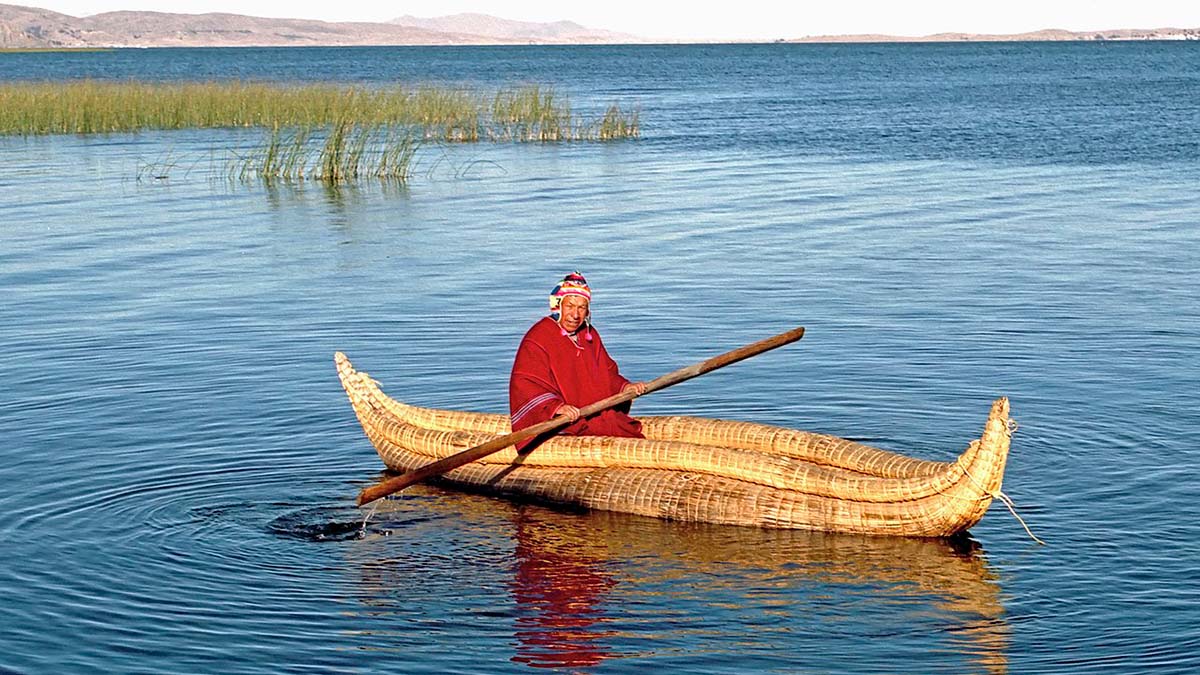
Lessons In Environmental & Cultural Preservation
by Alice Driver
My husband, Isaac Bingham, won a Watson Fellowship to fund a year-long project titled Savants of the Sea: Boat Building on Two Sides of the Pacific. Although I am not a boat builder by trade, I was overjoyed participate in the project. We began the project in Vietnam in late July of 2006.
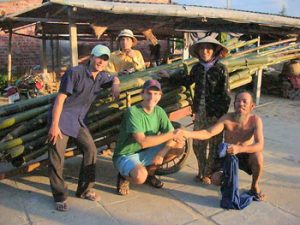 Traveling down the coast we met Anh Lu, a bamboo coracle builder with a hearty laugh and boundless energy who loved to shout “number one, number one!” as a compliment. Anh Lu, his wife Chi Bay, their sons and Isaac cut the bamboo, the first step in the process of building the coracle. The coracle takes around 15 days to build, and lasts for five to seven years. Local fishermen use the small coracles to fish along the coast to provide food for their families. However, in recent years huge trawlers have depleted the fish supply, and local fishermen often return from a morning of fishing with no fish. When I went out fishing from 4-6am one morning, the fisherman, Anh Taht, caught three small fish.
Traveling down the coast we met Anh Lu, a bamboo coracle builder with a hearty laugh and boundless energy who loved to shout “number one, number one!” as a compliment. Anh Lu, his wife Chi Bay, their sons and Isaac cut the bamboo, the first step in the process of building the coracle. The coracle takes around 15 days to build, and lasts for five to seven years. Local fishermen use the small coracles to fish along the coast to provide food for their families. However, in recent years huge trawlers have depleted the fish supply, and local fishermen often return from a morning of fishing with no fish. When I went out fishing from 4-6am one morning, the fisherman, Anh Taht, caught three small fish.
This unfinished Moken Kabang (boat) is reminiscent of the ribs of a prehistoric animal. The Moken people, also known as Sea Gypsies, up until the 1980’s, lived on these boats year-around, stopping at islands in Thailand and Myanmar to collect water or food. This group now lives in a village on the Surin Islands in Thailand. Aside from rice most of their diet comes from the sea; common cooking ingredients include: fish paste, chili, sea cucumber and sea worms. Although turtle curry used to be a favorite dish, the National Park no longer allows the Moken to hunt turtles. Influences from modernity can be seen as toddlers walk around with cans of coke and cups of instant noodles.
 The man resting against the hull of the boat is Salama, the village leader and a boat builder. He has been working on the boat on and off for two years while caring for his sick mother-in-law, and he expects to finish soon. He told me, “I learned to build boats from my grandfather and father. It is important for me to use the boat until I die.” The scene juxtaposes the Moken Kabang, a vestige of traditional Moken life, with a bay full of modern longtail fishing boats.
The man resting against the hull of the boat is Salama, the village leader and a boat builder. He has been working on the boat on and off for two years while caring for his sick mother-in-law, and he expects to finish soon. He told me, “I learned to build boats from my grandfather and father. It is important for me to use the boat until I die.” The scene juxtaposes the Moken Kabang, a vestige of traditional Moken life, with a bay full of modern longtail fishing boats.
We lived for a month with a Bajau family on Bumbun Island in the Sabah province of Malaysia. The whole village is on stilts over the sea, and, since there is no method of trash collection, residents often throw trash into the sea. At high tide flip flops, plastic bottles, feces, shoes, candy wrappers and old t-shirts float among the houses. When the tide washes the trash away kids go swimming and families go fishing.
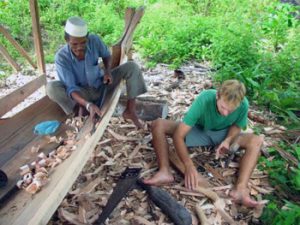 T’lao lives in Tokelau on the northernmost atoll of Atafu and spends his Saturday afternoons swimming with his family in the pristine lagoon. The three atolls of Tokelau, a protectorate of New Zealand, are a rough 36 hour boat ride north of Western Samoa. Until recently the population subsisted on a diet of raw fish, coconuts and bread fruit. Now a supply boat visits the atolls every two weeks, flooding them with imported goods, products and all the accompanying problems: the population wrestles with diseases such as obesity and diabetes, but the nearest hospital is 36 hours away. Trash produced by the imported goods is gathered and separated into piles. Plastic and paper are burned, the charred remains to be found in uninhabited areas of the atolls. Bottles and soda cans are stacked to be taken back on the next boat and recycled. Metal tins are punctured, flattened, put in 50 gallon drums and sunk in the ocean.
T’lao lives in Tokelau on the northernmost atoll of Atafu and spends his Saturday afternoons swimming with his family in the pristine lagoon. The three atolls of Tokelau, a protectorate of New Zealand, are a rough 36 hour boat ride north of Western Samoa. Until recently the population subsisted on a diet of raw fish, coconuts and bread fruit. Now a supply boat visits the atolls every two weeks, flooding them with imported goods, products and all the accompanying problems: the population wrestles with diseases such as obesity and diabetes, but the nearest hospital is 36 hours away. Trash produced by the imported goods is gathered and separated into piles. Plastic and paper are burned, the charred remains to be found in uninhabited areas of the atolls. Bottles and soda cans are stacked to be taken back on the next boat and recycled. Metal tins are punctured, flattened, put in 50 gallon drums and sunk in the ocean.
The Tokelauan men use an aluminum dinghy to go fishing for bait at dawn. Although the handmade Tokelauan outrigger canoe (Vaka) lasts for 100 years when maintained, locals now predominantly use dinghies which last a mere 7-10 years. The dinghies are lighter and easier for individuals to use, but have had several unforeseen repercussions. For example, men in the community used to fish for bait by simply dropping lines off the side of the Vaka. The use of dinghies forces the men to jump out of the boat. Why? The slapping of the water against the metal dingy scares the fish away.
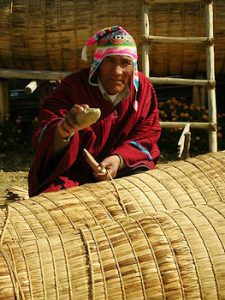 Dimitrio Limachi works on a reed boat in front of his house in Huatajata, Bolivia. Three families this small town – the Estebans, the Limachis and the Cataris – have maintained the reed boat building tradition. This method of boat building has been conserved in large part by the influx of money and interest prompted by expeditions like those of Thor Heyerdahl. He employed the Limachi family to build Ra II, a 12 meter reed vessel, to sail from Morocco to the Barbados.
Dimitrio Limachi works on a reed boat in front of his house in Huatajata, Bolivia. Three families this small town – the Estebans, the Limachis and the Cataris – have maintained the reed boat building tradition. This method of boat building has been conserved in large part by the influx of money and interest prompted by expeditions like those of Thor Heyerdahl. He employed the Limachi family to build Ra II, a 12 meter reed vessel, to sail from Morocco to the Barbados.
Since the time of Heyerdahl these families have built boats for nearly 20 large scale expeditions, including Abora III which set sail from New York in July of 2007 and attempted to reach Tenerife, Spain.
On Lake Titicaca there are floating islands made of reeds. Reed boats are made almost exclusively to attract tourists, who provide the main source of income for inhabitants of the islands. Fishermen use wooden rowboats for fishing, and make larger reed boats to ferry tourists among the islands.
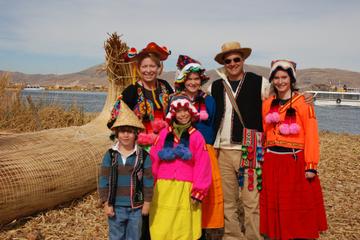
Day Tour of the Uros Floating Islands and Taquile Island
Further Information:
Glimpses of Traditional Boatbuilding in Goa
Thor Heyerdahl: The Kon Tiki Museum
About the author:
Alice Driver is a PhD student in Hispanic Studies at the University of Kentucky. Her travel writing has appeared in Transitions Abroad, Abroad View and the travel guide To Vietnam With Love. Her most recent academic article, an interview with Colombian film director Victor Gaviria, will be published in the Arizona Journal of Hispanic Cultural Studies in January of 2009.
Contact: alice.driver@uky.edu – www.as.uky.edu/HispanicStudies
Photo Credits:
First Bolivian reed boat by Dennis Jarvis from Halifax, Canada / CC BY-SA
All other photos are by Alice Driver and Isaac Bingham.




